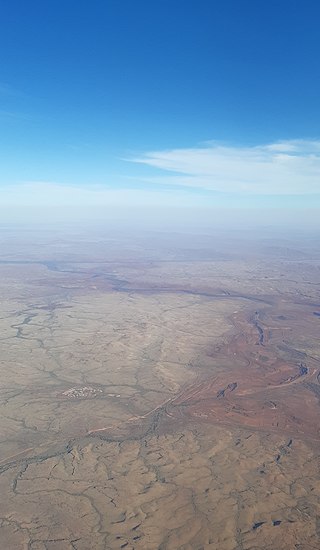
Railways in Western Australia were developed in the 19th century both by the Government of Western Australia and a number of private companies. Today passenger rail services are controlled by the Public Transport Authority through Transperth, which operates public transport in Perth, and Transwa, which operates country passenger services. Journey Beyond operates the Indian Pacific.

Fortescue is a global metal mining and green energy company headquartered in Australia. Fortescue focused on iron ore mining under the name of Fortescue Metals Group (FMG) until July 2023. As of 2017, Fortescue is the fourth-largest iron ore producer in the world. The company has holdings of more than 87,000 km2 in the Pilbara region of Western Australia, making it the largest tenement holder in the state, larger than both BHP and Rio Tinto.

The Hamersley & Robe River railway, majority-owned by Rio Tinto, and operated by its subsidiary Pilbara Iron, is a private rail network in the Pilbara region of Western Australia for the purpose of carrying iron ore. The network is larger than any other Australian heavy freight rail network in private ownership. The total length of its track is about 1,700 km (1,056 mi).

The Goldsworthy railway, owned and operated by BHP, is a private rail network in the Pilbara region of Western Australia built to carry iron ore. It is one of two railway lines BHP operates in the Pilbara, the other being the Mount Newman railway.

The Mount Newman railway, owned and operated by BHP, is a private rail network in the Pilbara region of Western Australia built to carry iron ore. It is one of two railway lines BHP operates in the Pilbara, the other being the Goldsworthy railway.

The Fortescue railway, owned and operated by Fortescue Metals Group (FMG), is a private rail network in the Pilbara region of Western Australia built to carry iron ore. It opened in 2008. When it was completed, it was the heaviest haul railway in the world, designed for 40 tonne axle loads, 2.5 to 5 tonnes heavier than the other Pilbara iron ore rail systems. On 4 November 2014, FMG Rail commenced trialling 42-tonne axle loads.

The Cloudbreak mine is an iron ore mine located in the Pilbara region of Western Australia, 89 kilometres west-south-west of Nullagine, in the Chichester Range.
The Yandicoogina mine, often shortened to Yandi, is an iron ore mine located in the Pilbara region of Western Australia, 95 kilometres north-west of Newman. it should not be confused with BHP Billiton's Yandi mine, which is located nearby.
The Hope Downs mine is an iron ore mining complex located in the Pilbara region of Western Australia. It comprises four large open-pit mines. The mines are co-owned by the Hancock Group and Rio Tinto, and the complex was named after Hope Hancock.

The Mount Whaleback mine, officially the Newman West operation, is an iron ore mine located in the Pilbara region of Western Australia, six kilometres west of Newman.
The Christmas Creek mine is an iron ore mine located in the Pilbara region of Western Australia, 61 kilometres south-south-west of Nullagine, in the Chichester Range.

Iron ore mining in Western Australia, in the 2018–19 financial year, accounted for 54 percent of the total value of the state's resource production, with a value of A$78.2 billion. The overall value of the minerals and petroleum industry in Western Australia was A$145 billion in 2018–19, a 26 percent increase on the previous financial year.
The Area C mine is an iron ore mine located in the Pilbara region of Western Australia, 92 kilometres west-north-west of Newman.
The Jimblebar mine is an iron ore mine located in the Pilbara region of Western Australia, 41 kilometres east of Newman.
The Pardoo mine was an iron ore mine located in the Pilbara region of Western Australia, 75 kilometres east of Port Hedland.
The Yarrie mine is an iron ore mine located in the Pilbara region of Western Australia, 90 kilometres north-east of Marble Bar.

The Yandi mine is an iron ore mine located in the Pilbara region of Western Australia, 90 kilometres north-west of Newman. It should not be confused with Rio Tinto's nearby Yandicoogina mine, which is also sometimes shortened to Yandi.
The Orebodies 18, 23 and 25 mine, part of BHP's Eastern Ridge hub and officially referred to as the Newman East operation, is an iron ore mine located in the Pilbara region of Western Australia, 8 kilometres east of Newman. The mine is majority-owned and operated by BHP, and is one of seven iron ore mines the company operates in the Pilbara. The company also operates two port facilities at Port Hedland, Nelson Point and Finucane Island, and over 1,000 kilometres of rail in the Pilbara.
The Railways in the Pilbara are a collection of railways in the Pilbara region of north-west Western Australia.

The Roy Hill railway, officially the Roy Hill Infrastructure railway, owned and operated by Hancock Prospecting, is a private rail network in the Pilbara region of Western Australia built to carry iron ore.











